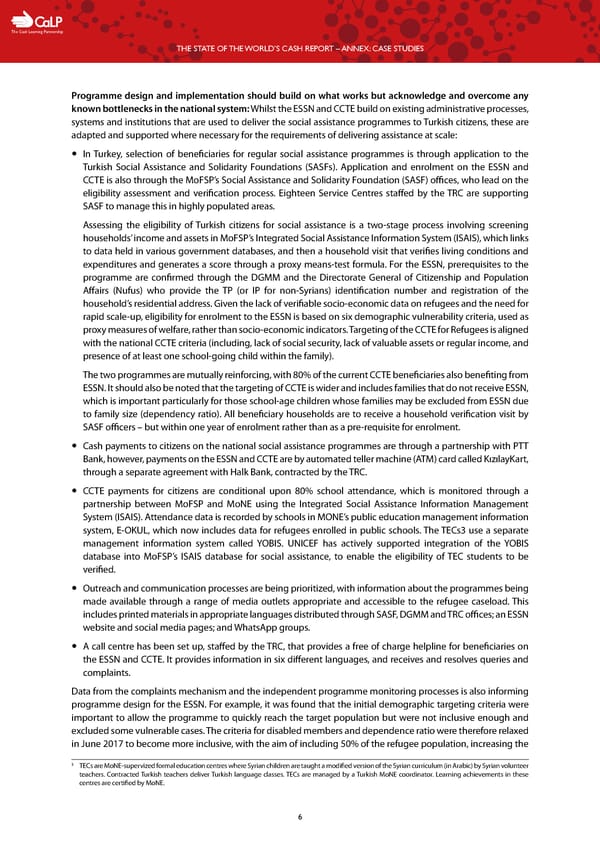C The Cash Learning Partnership THE STATE OF THE WORLD’S CASH REPORT – ANNEX: CASE STUDIES Programme design and implementation should build on what works but acknowledge and overcome any known bottlenecks in the national system: Whilst the ESSN and CCTE build on existing administrative processes, systems and institutions that are used to deliver the social assistance programmes to Turkish citizens, these are adapted and supported where necessary for the requirements of delivering assistance at scale: — In Turkey, selection of beneficiaries for regular social assistance programmes is through application to the Turkish Social Assistance and Solidarity Foundations (SASFs). Application and enrolment on the ESSN and CCTE is also through the MoFSP’s Social Assistance and Solidarity Foundation (SASF) offices, who lead on the eligibility assessment and verification process. Eighteen Service Centres staffed by the TRC are supporting SASF to manage this in highly populated areas. Assessing the eligibility of Turkish citizens for social assistance is a two-stage process involving screening households’ income and assets in MoFSP’s Integrated Social Assistance Information System (ISAIS), which links to data held in various government databases, and then a household visit that verifies living conditions and expenditures and generates a score through a proxy means-test formula. For the ESSN, prerequisites to the programme are confirmed through the DGMM and the Directorate General of Citizenship and Population Affairs (Nufus) who provide the TP (or IP for non-Syrians) identification number and registration of the household’s residential address. Given the lack of verifiable socio-economic data on refugees and the need for rapid scale-up, eligibility for enrolment to the ESSN is based on six demographic vulnerability criteria, used as proxy measures of welfare, rather than socio-economic indicators. Targeting of the CCTE for Refugees is aligned with the national CCTE criteria (including, lack of social security, lack of valuable assets or regular income, and presence of at least one school-going child within the family). The two programmes are mutually reinforcing, with 80% of the current CCTE beneficiaries also benefiting from ESSN. It should also be noted that the targeting of CCTE is wider and includes families that do not receive ESSN, which is important particularly for those school-age children whose families may be excluded from ESSN due to family size (dependency ratio). All beneficiary households are to receive a household verification visit by SASF officers – but within one year of enrolment rather than as a pre-requisite for enrolment. — Cash payments to citizens on the national social assistance programmes are through a partnership with PTT Bank, however, payments on the ESSN and CCTE are by automated teller machine (ATM) card called KızılayKart, through a separate agreement with Halk Bank, contracted by the TRC. — CCTE payments for citizens are conditional upon 80% school attendance, which is monitored through a partnership between MoFSP and MoNE using the Integrated Social Assistance Information Management System (ISAIS). Attendance data is recorded by schools in MONE’s public education management information system, E-OKUL, which now includes data for refugees enrolled in public schools. The TECs3 use a separate management information system called YOBIS. UNICEF has actively supported integration of the YOBIS database into MoFSP’s ISAIS database for social assistance, to enable the eligibility of TEC students to be verified. — Outreach and communication processes are being prioritized, with information about the programmes being made available through a range of media outlets appropriate and accessible to the refugee caseload. This includes printed materials in appropriate languages distributed through SASF, DGMM and TRC offices; an ESSN website and social media pages; and WhatsApp groups. — A call centre has been set up, staffed by the TRC, that provides a free of charge helpline for beneficiaries on the ESSN and CCTE. It provides information in six different languages, and receives and resolves queries and complaints. Data from the complaints mechanism and the independent programme monitoring processes is also informing programme design for the ESSN. For example, it was found that the initial demographic targeting criteria were important to allow the programme to quickly reach the target population but were not inclusive enough and excluded some vulnerable cases. The criteria for disabled members and dependence ratio were therefore relaxed in June 2017 to become more inclusive, with the aim of including 50% of the refugee population, increasing the 3 TECs are MoNE-supervized formal education centres where Syrian children are taught a modified version of the Syrian curriculum (in Arabic) by Syrian volunteer teachers. Contracted Turkish teachers deliver Turkish language classes. TECs are managed by a Turkish MoNE coordinator. Learning achievements in these centres are certified by MoNE. 6
 The State of the World's Cash | Case Studies Page 7 Page 9
The State of the World's Cash | Case Studies Page 7 Page 9